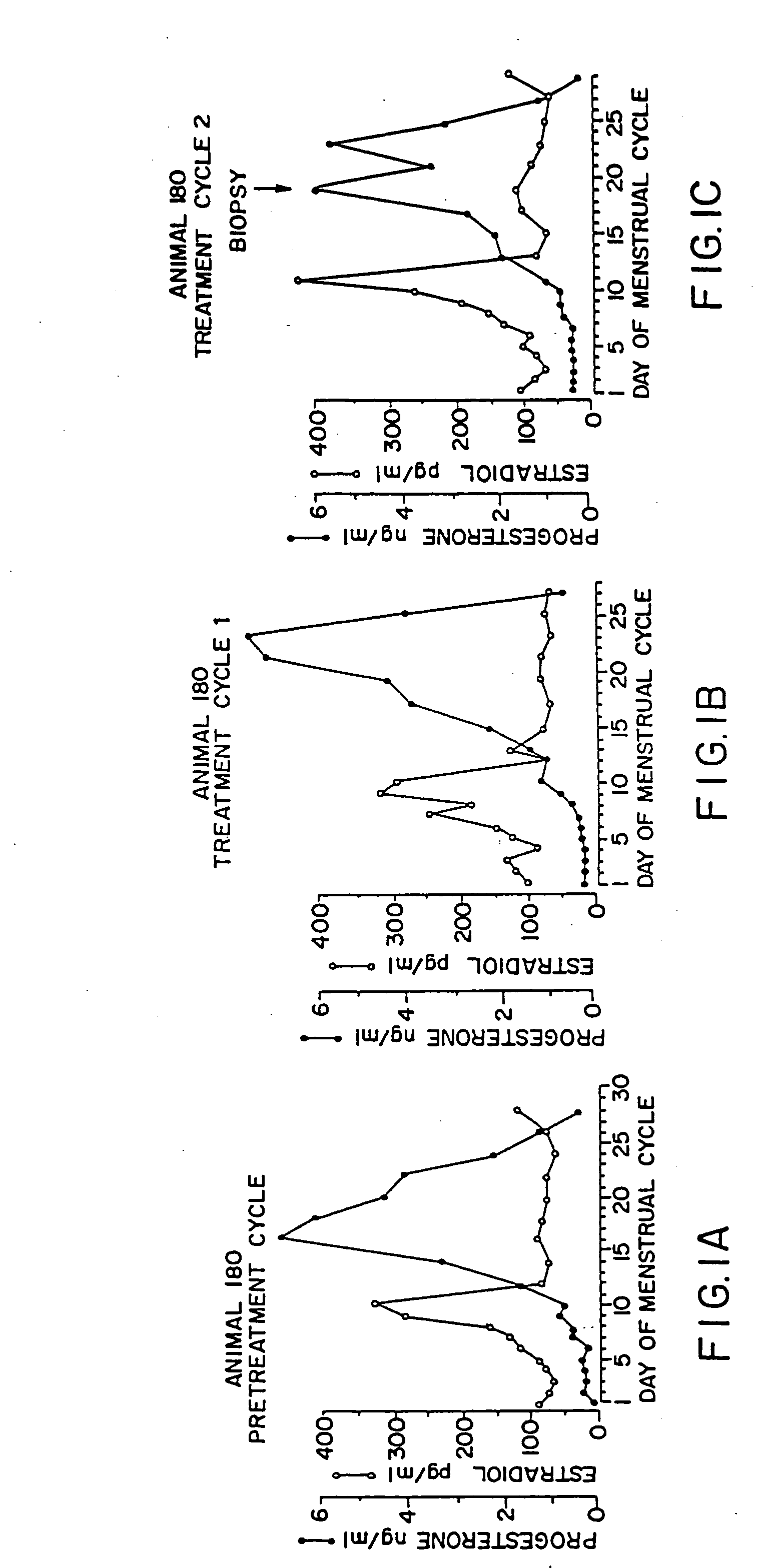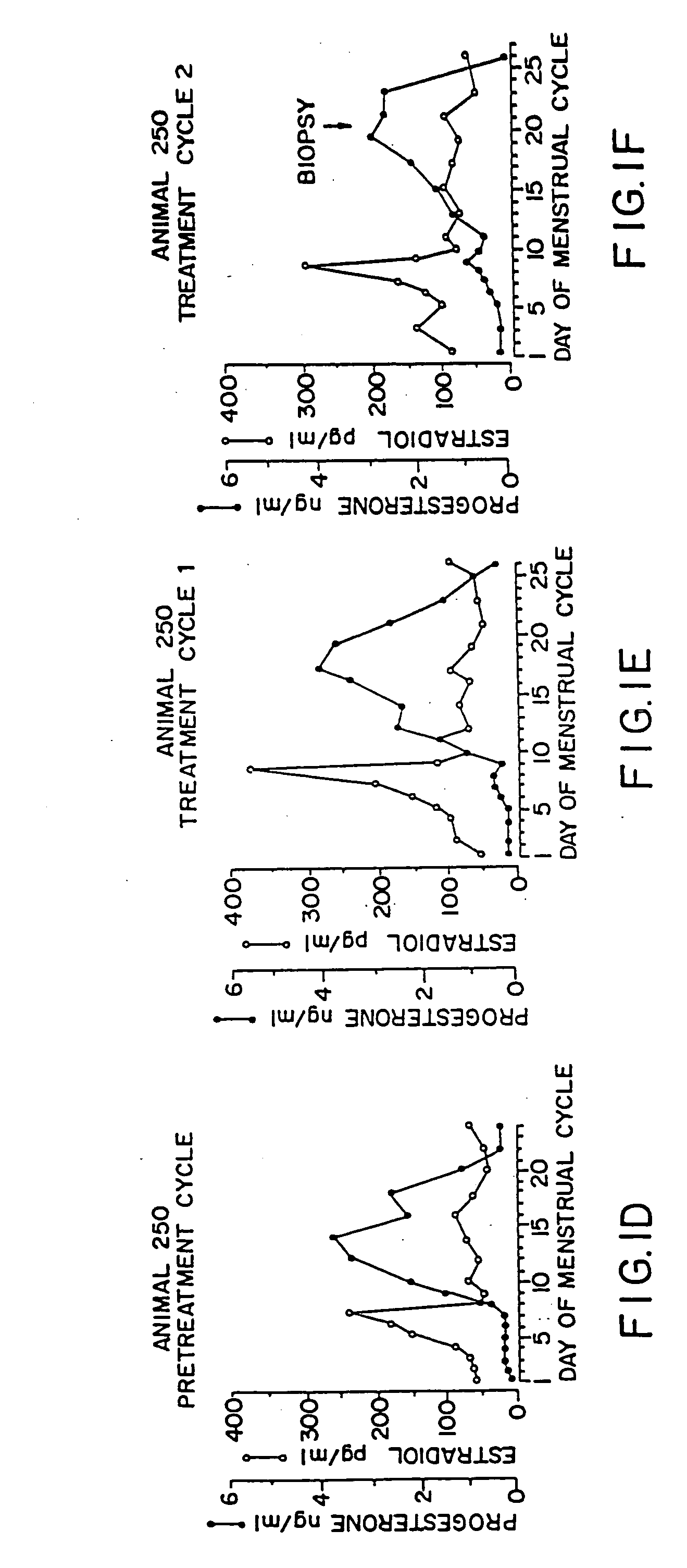Contraception method using competitive progesterone antagonists and novel compounds useful therein
a progesterone antagonist and contraception technology, applied in the direction of drug compositions, biocide, sexual disorders, etc., can solve the problem of inability to achieve reliable conception without ovulation inhibition, and achieve the effect of inhibiting the formation of endometrial glands and epithelium growth
- Summary
- Abstract
- Description
- Claims
- Application Information
AI Technical Summary
Benefits of technology
Problems solved by technology
Method used
Image
Examples
example 1
PREPARATIVE EXAMPLE 1
11β,19-[4-(4-Cyanophenyl)-o-phenylene-]17β-hydroxy-17α-(3-hydroxyprop-1(Z)-enyl)-4-androsten-3-one
a) 3,3-Dimethyltrimethylenedioxy-11β,19-(4-nonafluoro-butylsulfonyloxy-o-phenylene)-androstane-5α,17β-diol
50 g of 3,3-dimethyltrimethylenedioxy-11β,19-(4-hydroxy-o-phenylene)-androstane-5α,17β-diol (Example 18a of PCT application PCT / DE88 / 00150 whose disclosure is incorporated herein by reference) is dissolved under protective gas in 1.75 l of tetrahydrofuran (slightly clouded solution) and mixed at 0° C. with 71.3 ml of n-butyllithium solution (1.6 m in hexane). After 30 minutes of stirring, 22.8 ml of 1,1,2,2,3,3,4,4,4-nonafluoro-1-butanesulfonyl fluoride (−90%) is instilled. After one hour of stirring with ice bath cooling, the reaction mixture is stirred into saturated sodium bicarbonate solution and intensively stirred for one more hour. Then, after adding ethyl acetate, the aqueous phase is separated and extracted several times with ethyl acetate. The combi...
example 2
PREPARATIVE EXAMPLE 2
11β,19-[4-(3-Pyridinyl)-o-phenylene]-17β-hydroxy-17α-(3-hydroxyprop-1(Z)-enyl)-4-androsten-3-one
a) 11β,19-[4-(3-Pyridinyl)-o-phenylene]-3,3-dimethyl-trimethylenedioxy-17α-[3-(tetrahydropyran-2-yloxy)-prop-1-inyl]-androstane-5α,17β-diol
13.7 g of the nonaflate produced under 1c) is dissolved in a mixture of 140 ml of toluene and 70 ml of ethanol and mixed in succession under protective gas with 877 mg of tetrakis(triphenylphosphine)palladium(0), 1.29 g of lithium chloride, 19 ml of 2 m sodium carbonate solution and 2.46 g of diethyl(3-pyridinyl)borane. The reaction mixture is then stirred for 2 hours at an oil bath temperature of 95° C., cooled to room temperature and mixed with water and ethyl acetate. The aqueous phase is separated and extracted with ethyl acetate. The combined organic phases are dried on sodium sulfate and concentrated by evaporation in a vacuum. The residue is chromatographed on silica gel with a mixture of ethyl acetate / hexane. 8.8 g of th...
formulation example 3
10.0 mgof 11β-[(4-N,N-dimethylamino)-phenyl]-17α-hydroxy-17β-(3-hydroxypropyl)-13α-methyl-4,9(10)-gonadien-3-one140.5 mgof lactose 69.5 mgof corn starch 2.5 mgof polyvinylpyrrolidone 25 2.0 mgof aerosil 0.5 mgof magnesium stearate225.0 mgtotal weight
Formulate the above composition into 10 mg. tablets for oral administration in a conventional manner.
For the use of the pharmaceutical agent produced according to the invention, it is critical that at least one dosage unit is administered in the follicular phase of the menstrual cycle (before the ovulation) and optionally at least one dosage unit is administered in the luteal phase of the menstrual cycle (after the ovulation).
Preferably, the pharmaceutical agent produced according to the invention is administered in individual dosage units every to 4 to every 10 days, preferably weekly or the same day, beginning on any day before ovulation occurs in the first administration menstrual cycle. The time intervals between administration...
PUM
| Property | Measurement | Unit |
|---|---|---|
| time | aaaaa | aaaaa |
| concentrations | aaaaa | aaaaa |
Abstract
Description
Claims
Application Information
 Login to View More
Login to View More - R&D
- Intellectual Property
- Life Sciences
- Materials
- Tech Scout
- Unparalleled Data Quality
- Higher Quality Content
- 60% Fewer Hallucinations
Browse by: Latest US Patents, China's latest patents, Technical Efficacy Thesaurus, Application Domain, Technology Topic, Popular Technical Reports.
© 2025 PatSnap. All rights reserved.Legal|Privacy policy|Modern Slavery Act Transparency Statement|Sitemap|About US| Contact US: help@patsnap.com



